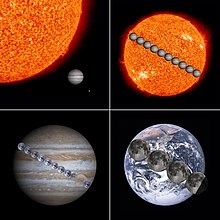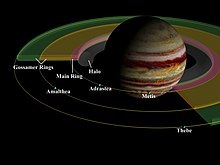|
|
| |
|
|
| |
|
|
|
|
| |
 |
| Full disk view in
natural color, taken by the Hubble Space
Telescope in April 2014. |
Jupiter
Jupiter is the largest planet in the Solar System. It is
the fifth planet from the Sun. Jupiter is a gas giant,
both because it is so large and made up of gas. The
other gas giants are Saturn, Uranus, and Neptune.
Jupiter has a mass of 1.8986×1027 kg, or about 318
Earths. This is twice the mass of all the other planets
in the Solar System put together.
Jupiter can be seen even without the use of telescope.
It was known to the ancient Romans, who named it after
their god Jupiter (Latin: Iuppiter). Jupiter is the
third brightest object in the night sky. Only the
Earth's moon and Venus are brighter.
Jupiter has at least 79 moons. Of these, around 50 are
very small and less than five kilometres wide. The four
largest moons of Jupiter are Io, Europa, Ganymede, and
Callisto. They are called the Galilean moons, because
Galileo Galilei discovered them. Ganymede is the largest
moon in the Solar System. It is larger in diameter than
Mercury. In 2018 another ten very small moons were
discovered |
|
 |
| Jupiter's diameter
is one order of magnitude smaller (×0.10045)
than that of the Sun, and one order of magnitude
larger (×10.9733) than that of Earth. The Great
Red Spot is roughly the same size as Earth. |
Structure
Jupiter is the biggest planet in the Solar System with a
diameter of 142,984 km. This is eleven times bigger than
the diameter of Earth.
Atmosphere
The atmosphere near the surface of Jupiter is made of
about 88 to 92% hydrogen, 8 to 12% helium, and 1% other
gases.
The lower atmosphere is so heated and the pressure so
high that helium changes to liquid. It rains down onto
the planet. Based on spectroscopy, Jupiter seems to be
made of the same gases as Saturn. It is different from
Neptune or Uranus. These two planets have much less
hydrogen and helium gas.
The very high temperatures and pressures in Jupiter's
core mean scientists cannot tell what materials would be
there. This cannot be found out, because it is not
possible to create the same amount of pressure on Earth.
Above the unknown inner core is an outer core. The outer
core of Jupiter is thick, liquid hydrogen. The pressure
is high enough to make the hydrogen solid, but then it
melts because of the heat.
Mass
Jupiter is twice as massive as all the other planets in
the Solar System put together. It gives off more heat
than it gets from the sun. Jupiter is 11 times the width
of Earth and 318 times as massive. The volume of Jupiter
is 1,317 times the volume of Earth. In other words,
1,317 Earth-sized objects could fit inside it.
Cloud layers
Jupiter has many bands of clouds going horizontally
across its surface. The light parts are zones and the
darker are belts. The zones and belts often interact
with each other. This causes huge storms. Wind speeds of
360 kilometres per hour (km/h) are common on Jupiter. To
show the difference the strongest tropical storms on
Earth are about 100 km/h.
Most of the clouds on Jupiter are made of ammonia. There
may also be clouds of water vapour like clouds on Earth.
Spacecrafts such as Voyager 1 have seen lightning on the
surface of the planet. Scientists think it was water
vapour because lightning needs water vapour. These
lightning bolts have been measured as up 1,000 times as
powerful as those on Earth. The brown and orange colours
are caused when sunlight passes through or refracts with
the many gases in the atmosphere. |
 |
| The Great Red Spot
is decreasing in size (May 15, 2014). |
Great Red Spot
One of the biggest features in Jupiter's atmosphere is
the Great Red Spot. It is a huge storm which is bigger
than the entire Earth. It is on record since at least
1831, and as early as 1665. Images by the Hubble Space
Telescope have shown as many as two smaller "red spots"
right next to the Great Red Spot. Storms can last for
hours or as long as hundreds of years in the case of the
Great Red Spot.
Magnetic field
Jupiter has a magnetic field like Earth's but 11 times
stronger. It also has a magnetosphere much bigger and
stronger than Earth's. The field traps radiation belts
much stronger than Earth's Van Allen radiation belts,
strong enough to endanger any spacecraft travelling past
or to Jupiter. The magnetic field is probably caused by
the large amounts of liquid metallic hydrogen in the
core of Jupiter. The four largest moons of Jupiter and
many of the smaller ones orbit or go around the planet
within the magnetic field. This protects them from the
solar wind. Jupiter's magnetic field is so large, it
reaches the orbit of Saturn 7.7 million miles (12
million km) away. The Earth's magnetosphere does not
even cover its moon, less than a quarter of a million
miles (400,000 km) away. |
 |
| The rings of
Jupiter. |
Ring system
Jupiter also has a thin planetary ring system. These
rings are difficult to see and were not discovered until
1979 by NASA's Voyager 1 probe. There are four parts to
Jupiter's rings. The closest ring to Jupiter is called
the Halo Ring. The next ring is called the Main Ring. It
is about 6,440 km (4,002 mi) wide and only 30 km (19 mi)
thick. The Main and Halo rings of Jupiter are made of
small, dark particles. The third and fourth rings,
called the Gossamer Rings, are transparent (see through)
and are made from microscopic debris and dust. This dust
probably comes from small meteors striking the surface
of Jupiter's moons. The third ring is called the
Amalthea Gossamer Ring, named after moon Amalthea. The
outer ring, the Thebe Gossamer Ring, is named after the
moon Thebe. The outer edge of this ring is about 220,000
km (136,702 mi) from Jupiter. |
|
Orbit
The orbit of a planet is the time and path it takes to
go around the Sun. In the amount of time it takes for
Jupiter to orbit the Sun one time, the Earth orbits the
Sun 11.86 times. One year on Jupiter is equal to 11.86
years on Earth. The average distance between Jupiter and
the Sun is 778 million kilometres. This is five times
the distance between Earth and the Sun. Jupiter is not
tilted on its axis as much as Earth or Mars. This causes
it to have no seasons, for example summer or winter.
Jupiter rotates, or spins around very quickly. This
causes the planet to bulge in the middle. Jupiter is the
fastest spinning planet in the Solar System. It
completes one rotation or spin in 10 hours. Because of
the bulge, the length of the equator of Jupiter is much
longer than the length from pole to pole.
Research and exploration
From Earth
Jupiter is the third brightest object in the night sky,
after the Moon and Venus. Because of that, people have
always been able to see it from Earth. The first person
known to really study the planet was Galileo Galilei in
1610. He was the first person to see Jupiter's moons Io,
Europa, Ganymede and Callisto. This was because he used
a telescope, unlike anyone before him.
No new moons were discovered for more than two hundred
years. In 1892, astronomer E.E Barnard found a new moon
using his observatory in California. He called the moon
Amalthea. It was the last of Jupiter's 67 moons to be
discovered by human observation through a telescope. In
1994, bits of the comet Shoemaker Levy-9 hit Jupiter. It
was the first time people saw a collision between two
Solar System objects.
From spacecraft
Seven spacecraft have flown past Jupiter since 1973.
These were Pioneer 10 (1973), Pioneer 11 (1974),
Voyagers 1 and 2 (1979), Ulysses (1992 and 2004),
Cassini (2000) and New Horizons (2007).
The Pioneer missions were the first spacecraft to take
close up pictures of Jupiter and its moons. Five years
later, the two Voyager spacecraft discovered over 20 new
moons. They captured photo evidence of lightning on the
night side of Jupiter.
The Ulysses probe was sent to study the Sun. It only
went to Jupiter after it had finished its main mission.
Ulysses had no cameras so it took no photographs. In
2006, the Cassini spacecraft, on its way to Saturn, took
some very good, very clear pictures of the planet.
Cassini also found a moon and took a picture of it but
it was too far away to show the details.
The Galileo mission in 1995 was the first spacecraft to
go into orbit around Jupiter. It flew around the planet
for seven years and studied the four biggest moons. It
launched a probe into the planet to get information
about Jupiter's atmosphere. The probe travelled to a
depth of about 150 km before it was crushed by the
weight of all the gas above it. This is called pressure.
The Galileo spacecraft was also crushed in 2003 when
NASA steered the craft into the planet. They did this so
that the craft could not crash into Europa, a moon which
scientists think might have life.
NASA have sent another spacecraft to Jupiter called
Juno. It was launched on August 5, 2011 and arrived at
Jupiter on July 4, 2016. NASA published some results
from the Juno mission in March 2018. Several other
missions have been planned to send spacecraft to
Jupiter's moons Europa and Callisto. One called JIMO
(Jupiter Icy Moons Orbiter) was cancelled in 2006
because it cost too much money. |
|
Moons
Jupiter has 79 known moons. The four largest were seen
by Galileo with his primitive telescope, and nine more
can be seen from Earth with modern telescopes. The rest
of the moons have been identified by spacecraft. The
smallest moon (S/2003 J 12) is only one kilometre
across. The largest, Ganymede, has a diameter of 5,262
kilometres. It is bigger than the planet Mercury. The
other three Galilean moons are Io, Europa and Callisto.
Because of the way they orbit Jupiter, gravity affects
three of these moons greatly. The friction caused by the
gravity of Europa and Ganymede pulling on Io makes it
the most volcanic object in the Solar System. It has
over 400 volcanoes, more than three times as many as
Earth.
Jupiter in the Solar System
Jupiter's large gravity has had an effect on the Solar
System. Jupiter protects the inner planets from comets
by pulling them towards itself. Because of this, Jupiter
has the most comet impacts in the Solar System.
Two groups of asteroids, called Trojan asteroids, have
settled into Jupiter's orbit round the Sun. One group is
called the Trojans and the other group is called the
Greeks. They go around the Sun at the same time as
Jupiter. |
|
 Kiddle:
Jupiter Kiddle:
Jupiter
Wikipedia: Jupiter |
|
|
|
|
|
|
|
|
|
|
|
|
|
|
|
|
Search Fun Easy English |
|
|
|
|
|
|
|
|
|
|
|
|
|
|
|
About
Contact
Copyright
Resources
Site Map |